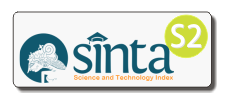Money Laundering Observation from Outer Space
Abstract
Keywords
Full Text:
PDFReferences
Andiojaya, A., Nefriana, R. R., Rizka, R., & Lestari, T. K. (2022). GDP forecasting through nighttime-light data: Evidence from Indonesia. Jurnal Inovasi Ekonomi, 7(4). https://doi.org/10.22219/jiko.v7i04.20239
Canhoto, A. I. (2021). Leveraging machine learning in the global fight against money laundering and terrorism financing: An affordances perspective. Journal of Business Research, 131, 441–452. https://doi.org/10.1016/j.jbusres.2020.10.012
Chotia, V., & Rao, N. V. M. (2017). Investigating the interlinkages between infrastructure development, poverty and rural–urban income inequality: Evidence from BRICS nations. Studies in Economics and Finance, 34(4), 466–484. https://doi.org/10.1108/SEF-07-2016-0159
Doll, C. N. H., Muller, J.-P., & Morley, J. G. (2006). Mapping regional economic activity from night-time light satellite imagery. Ecological Economics, 57(1), 75–92. https://doi.org/10.1016/j.ecolecon.2005.03.007
Domashova, J., & Mikhailina, N. (2021). Usage of machine learning methods for early detection of money laundering schemes. Procedia Computer Science, 190, 184–192. https://doi.org/10.1016/j.procs.2021.06.033
Ekananda, M. (2018). Analisis Ekonometrika Data Panel Edisi 2: Teori Lengkap Dan Pembahasan Menyeluruh Bagi Peneliti Ekonomi, Bisnis, Dan Sosial (2nd ed.). Mitra Wacana Media.
Gibson, J., Olivia, S., Boe-Gibson, G., & Li, C. (2021). Which night lights data should we use in economics, and where? Journal of Development Economics, 149, 102602. https://doi.org/10.1016/j.jdeveco.2020.102602
Greene, W. H. (2012). Econometric analysis (7th ed). Prentice Hall.
Gujarati, D. N., & Porter, D. C. (2009). Basic econometrics (5th ed). McGraw-Hill Irwin.
Henderson, J. V., Storeygard, A., & Weil, D. N. (2012). Measuring Economic Growth from Outer Space. American Economic Review, 102(2), 994–1028. https://doi.org/10.1257/aer.102.2.994
Mills, S., Weiss, S., & Liang, C. (2013). VIIRS day/night band (DNB) stray light characterization and correction (J. J. Butler, X. (Jack) Xiong, & X. Gu, Eds.; p. 88661P). https://doi.org/10.1117/12.2023107
Mncube, Z., & Xulu, S. (2022). Progress of nighttime light applications within the google earth engine cloud platform. Geocarto International, 1–22. https://doi.org/10.1080/10106049.2022.2120550
OECD. (2020). Strategic Foresight for the COVID-19 Crisis and Beyond: Using Futures Thinking to Design Better Public Policies. OECD Publishing Paris.
Peng, C., Sun, W., & Zhang, X. (2022). Crime under the Light? Examining the Effects of Nighttime Lighting on Crime in China. Land, 11(12), 2305. https://doi.org/10.3390/land11122305
PPATK. (2021). Buletin Statistik Anti Pencucian Uang dan Pencegahan Pendanaan Terorisme (APUPPT) (Desember 2021, Vol. 142). Pusat Pelaporan dan Analisis Transaksi Keuangan.
Reznik, O., Utkina, M., & Bondarenko, O. (2023). Financial intelligence (monitoring) as an effective way in the field of combating money laundering. Journal of Money Laundering Control, 26(1), 94–105. https://doi.org/10.1108/JMLC-09-2021-0102
Roberts, M. (2021). Tracking economic activity in response to the COVID-19 crisis using nighttime lights – The case of Morocco. Development Engineering, 6, 100067. https://doi.org/10.1016/j.deveng.2021.100067
Rocha-Salazar, J.-J., Segovia-Vargas, M.-J., & Camacho-Miñano, M.-M. (2021). Money laundering and terrorism financing detection using neural networks and an abnormality indicator. Expert Systems with Applications, 169, 114470. https://doi.org/10.1016/j.eswa.2020.114470
Skoufias, E., Strobl, E., & Tveit, T. (2019). Can we Rely on VIIRS Nightlights to Estimate the Short-Term Impacts of Natural Disasters? World Bank, Washington, DC. https://doi.org/10.1596/1813-9450-9052
Steele, J. E., Sundsøy, P. R., Pezzulo, C., Alegana, V. A., Bird, T. J., Blumenstock, J., Bjelland, J., Engø-Monsen, K., de Montjoye, Y.-A., Iqbal, A. M., Hadiuzzaman, K. N., Lu, X., Wetter, E., Tatem, A. J., & Bengtsson, L. (2017). Mapping poverty using mobile phone and satellite data. Journal of The Royal Society Interface, 14(127), 20160690. https://doi.org/10.1098/rsif.2016.0690
Viritha, B., Mariappan, V., & Haq, I. U. (2015). Suspicious transaction reporting: An Indian experience. Journal of Money Laundering Control, 18(1), 2–16. https://doi.org/10.1108/JMLC-11-2013-0046
Yang, B., Liu, L., Lan, M., Wang, Z., Zhou, H., & Yu, H. (2020). A spatio-temporal method for crime prediction using historical crime data and transitional zones identified from nightlight imagery. International Journal of Geographical Information Science, 34(9), 1740–1764. https://doi.org/10.1080/13658816.2020.1737701
DOI: http://dx.doi.org/10.17977/um002v16i12024p052
Refbacks
- There are currently no refbacks.
ISSN (Print) 2086-1575 ISSN (Online) 2502-7115

This work is licensed under a Creative Commons Attribution-NoDerivatives 4.0 International License.






